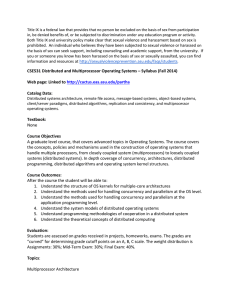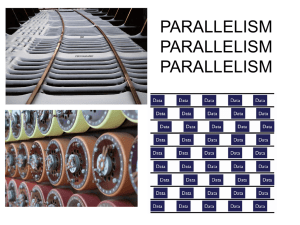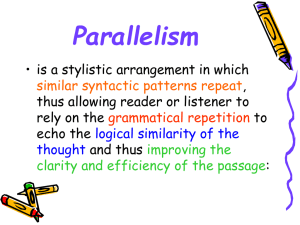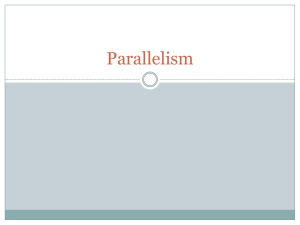ParallelJava_2012_1_Introduction
advertisement
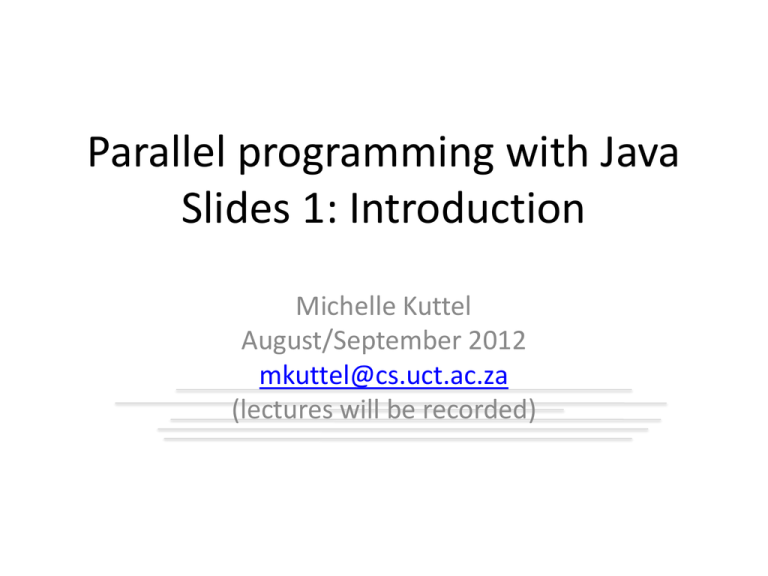
Parallel programming with Java
Slides 1: Introduction
Michelle Kuttel
August/September 2012
mkuttel@cs.uct.ac.za
(lectures will be recorded)
Changing a major assumption
So far, most or all of your study of
computer science has assumed that
one thing happens at a time
this is sequential programming
• everything is part of one sequence
start
end
ABCDEFGHIJKLMNOPQRSTUVWXYZ
This slide adapted from: Sophomoric Parallelism and Concurrency, Lecture 1, Dan Grossman
Changing a major assumption
end
start
Removing the sequential assumption
creates both opportunities and
challenges
ABCD
DEFGH
– Programming:
• Divide work among threads of execution T U V W X Y Z
and coordinate (synchronize) them
– Algorithms:
• more throughput: work done per unit
wall-clock time = speedup
• more organization required
– Data structures:
• May need to support concurrent access
(multiple threads operating on data at
the same time)
IJK
LM
R
NO P
S
Q
This slide adapted from: Sophomoric Parallelism and Concurrency, Lecture 1, Dan Grossman
Why is parallel programming
important?
Parallel programming is a lot of work…
Writing correct and efficient multithreaded code
is often much more difficult than for singlethreaded (i.e., sequential) code
– Especially in common languages like Java and C
– So typically stay sequential if possible
• Why is it necessary?
This slide adapted from: Sophomoric Parallelism and Concurrency, Lecture 1, Dan Grossman
Origins of Parallel Computing
• None of the “future is parallel” argument is
new :
“A Universal Computer Capable of Executing an
Arbitrary Number of Sub-programs
Simultaneously” J. Holland, 1959, Proc. East Joint
Computer Conference, Vol16, pp 108-113
Early Parallel Computing: ILLIAC IV
• ILLIAC IV project at University of Illinois 1965-76
• one of the most infamous supercomputers ever.
Designed to have fairly high parallelism:
• 256 processing elements driven by 4 CPUs
and a 13MHz clock.
•64-bit registers
BUT, the final machine
•had only 16 processors, due to costs escalating
from projected $8 million (1966) to $31 million
(1972)
•Had to be moved due to student protests
(Vietnam war)
In 1976 it ran its first successful application.
Used to perform computational fluid dynamics simulations, but
•actual performance of 15 MFLOPS compared to estimated performance of 1000 MFLOPS.
Photo Courtesy of Charles Babbage Institute, University of Minnesota, Minneapolis
Early Parallel Computing
Why not pursued more thoroughly before
1990’s?
• Because of dramatic increase in uniprocessor
speed, the need for parallelism turned out to
be less than expected
From roughly 1980-2005, desktop computers
became exponentially faster at running
sequential programs
– traditional doubling of clock speeds every 18–24
months
This slide adapted from: Sophomoric Parallelism and Concurrency, Lecture 1, Dan Grossman
Now, the “Power Wall”
Nobody knows how to continue the speed
increase
– Increasing clock rate generates too much heat:
power and cooling constraints limit increases in
microprocessor clock speeds
– Relative cost of memory access is too high
This slide adapted from: Sophomoric Parallelism and Concurrency, Lecture 1, Dan Grossman
Will Power Problems Curtail Processor Progress? Neal Leavitt, Computer, Vol 45, number 5, pages 15-17
Era of multicore
We can keep making “wires exponentially smaller”
(Moore’s “Law”), so put multiple processors on the
same chip (“multicore”)
– During the next decade, the level of parallelism on a
single microprocessor will rival the number of nodes
in the most massively parallel supercomputers of the
1980s*
– By 2020, extreme scale HPC systems are anticipated to
have on the order of 100,000–1,000,000 sockets, with
each socket containing between 100 and 1000
potentially heterogeneous cores*
• These enormous levels of concurrency must be
exploited efficiently to reap the benefits of such
exascale systems.
*Parallel Computing, Volume 37, Issue 9, September 2011, Pages 499-500, Emerging
Programming Paradigms for Large-Scale Scientific Computing
What to do with multiple processors?
Run multiple totally different programs at the
same time
– Already do that? Yes, but with time-slicing
Do multiple things at once in one program
– Our focus – more difficult
– Requires rethinking everything, from asymptotic
complexity to how to implement data-structure
operations
This slide from: Sophomoric Parallelism and Concurrency, Lecture 1
Why Parallel Programming?
• Multicore architectures are now ubiquitous
• Performance gain from multiprocessing hardware
• Increased application throughput
• an I/O call need only block one thread.
• Increased application responsiveness
• high priority thread for user requests.
• More appropriate structure
• for programs which interact with the environment, control
multiple activities and handle multiple events.
Why NOT parallel programming?
Increased pain (complexity) of the programs:
Managing this complexity and the principles
and techniques necessary for the construction
of well-behaved parallel/concurrent programs
is the main subject matter of this module
Concurrency versus parallelism
Parallel:
Use extra computational
resources to solve a
problem faster
work
resource
resource
resource
resource
resource
These terms are NOT standard, but perspective is important
Many programmers confuse these terms
Concurrent:
Correctly and efficiently
manage access to shared
resources
request
request
request
request
request
resource
*A Sophomoric Introduction to Shared-Memory Parallelism and Concurrency, Dan Grossman, online notes, version Feb 2012
Why is Parallel/Concurrent
Programming so Hard?
• Try preparing a seven-course banquet
– By yourself
– With one friend
– With twenty-seven friends …
Cooking analogy
A serial program is a recipe for one cook
– the cook does one thing at a time (sequential)
Parallel options
– use lots of helpers to slice lots of potatoes (data
decomposition)
– use helpers to dedicate to different tasks, such as
beating eggs, slicing onions, washing up (task
decomposition)
– have a list of tasks and assign them to workers as
they are free (work pool)
– But too many chefs = too much time coordinating!
This slide adapted from: Sophomoric Parallelism and Concurrency, Lecture 1, Dan Grossman
Cooking analogy
Concurrency example
– Lots of cooks making different things, but only 4
stove burners
– want to allow access to burners, but not cause
spills or incorrect burner settings
This slide adapted from: Sophomoric Parallelism and Concurrency, Lecture 1, Dan Grossman
Parallelism Example
Parallelism: Use extra computational resources to solve a
problem faster (increasing throughput via simultaneous
execution)
Pseudocode for array sum
– Bad style for reasons we’ll see, but may get roughly 4x speedup
int sum(int[] arr){
res = new int[4];
len = arr.length;
FORALL(i=0; i < 4; i++) { //parallel iterations
res[i] = sumRange(arr,i*len/4,(i+1)*len/4);
}
return res[0]+res[1]+res[2]+res[3];
}
int sumRange(int[] arr, int lo, int hi) {
result = 0;
for(j=lo; j < hi; j++)
result += arr[j];
return result;
}
This slide from: Sophomoric Parallelism and Concurrency, Dan Grossman
Concurrency Example
Concurrency: Correctly and efficiently manage access to shared
resources (from multiple possibly-simultaneous clients)
Pseudocode for a shared chaining hashtable
– Prevent bad interleaving (correctness)
– But allow some concurrent access (performance)
class Hashtable<K,V> {
…
void insert(K key, V value) {
int bucket = …;
prevent-other-inserts/lookups in table[bucket]
do the insertion
re-enable access to arr[bucket]
}
V lookup(K key) {
(like insert, but can allow concurrent
lookups to same bucket)
}
}
This slide from: Sophomoric Parallelism and Concurrency, Lecture 1, Dan Grossman
Focus on parallelism
• In reality, parallelism and concurrency are mixed
– Common to use threads for both
– If parallel computations need access to shared
resources, then the concurrency needs to be managed
• However, in the first half of this course we focus
on parallelism
– Structured, shared-nothing parallelism
• once you are comfortable with threads, we will
talk about mutual exclusion, interleaving etc.
This slide adapted from: Sophomoric Parallelism and Concurrency, Lecture 1, Dan Grossman
Where does parallel/concurrent
processing occur?
operating systems
supercomputers
internet and
distributed
computing systems
T
i
m
e
multicore chips
GPU’s and other
accelerators
Everywhere
Many programs today are inherently concurrent
or parallel:
• operating and real-time systems,
• event-based implementations of graphical
user interfaces,
• high-performance parallel simulations like
climate prediction using weather models,
• Internet applications like multiuser games,
chats and ecommerce.
This explosion of parallelism has two significant
challenges from a programming perspective:
• how to best manage all the available
resources to ensure the most efficient use of
the peak performance provided by the
hardware designs.
• how the enormous potential of these systems
can be effectively utilized by a wide spectrum
of scientists and engineers who are not
necessarily parallel programming experts.
from: Parallel Computing, Volume 37, Issue 9, September 2011,
Pages 499-500, Emerging Programming Paradigms for Large-Scale
Scientific Computing
What is a parallel computer?
Parallel processing is:
the use of multiple processors to execute different
parts of the same program simultaneously
But that is a bit vague, isn’t it?
What is a parallel computer?
TOP500
Created in 1993
• a list of the top 500 super computers
• updated twice yearly
• Each computer is ranked according to
performance on High Performance Linpack
(HPL) software package from the Innovative
Computing Laboratory at the University of
Tennessee:
– LINPACK provides 3 separate benchmarks to
evaluate a systems performance on a dense
system of linear equations
Class volunteer?
• Outline of machine currently at top of top500
The problem for application programmers is
further compounded by the diversity of
multicore architectures that are now
emerging, ranging from:
• complex out-of-order CPUs with deep cache
hierarchies,
• to relatively simple cores that support
hardware multithreading,
• to chips that require explicit use of softwarecontrolled memory.
from: Parallel Computing, Volume 37, Issue 9, September 2011,
Pages 499-500, Emerging Programming Paradigms for Large-Scale
Scientific Computing
A parallel computer is
• Multiple processors on multiple separate computers
working together on a problem (cluster)
• Or a computer with multiple internal processors
(multicore and/or multiCPUs) ,
• Or accelerators (GPU’s)
• Or multicore with GPU’s
• Or multicore with GPU’s in a cluster
• Or …a cloud?
• Or…. the internet?
Memory Parallelism
CPU
CPU
CPU
serial
computer
memory
memory
shared
memory
computer
CPU
CPU
CPU
CPU
memory
memory
memory
distributed
memory
computer
We focus on:
The Shared Memory Multiprocessor
(SMP)
cache
Bus
cache
Bus
shared memory
from: Art of Multiprocessor Programming
cache
• All memory is placed
into a single (physical)
address space.
• Processors connected
by some form of
interconnection
network
• Single virtual address
space across all of
memory. Each
processor can access all
locations in memory.
Communication between processes
Processes must communicate in order to
synchronize or exchange data
– if they don’t need to, then nothing to worry
about!
The challenge in concurrent programming comes
from the need to synchronize the execution of
different processes and to enable them to
communicate.
Broadly speaking, researchers have taken two paths
for leveraging the parallelism provide by modern
platforms:
• The first focuses on optimizing parallel programs
as aggressively as possible by leveraging the
knowledge of the underlying architecture
• The second path provides the tools, libraries, and
runtime systems to simplify the complexities of
parallel programming, without sacrificing
performance, thereby allowing domain experts to
leverage the potential of high-end systems.
from: Parallel Computing, Volume 37, Issue 9, September 2011,
Pages 499-500, Emerging Programming Paradigms for Large-Scale
Scientific Computing
Programming a Parallel Computer
• can be achieved by:
– an entirely new language – e.g. Erlang
– a directives-based data-parallel language e.g. HPF
(data parallelism), OpenMP (shared memory +
data parallelism)
– an existing high-level language in combination
with a library of external procedures for message
passing (MPI)
– threads (shared memory – Pthreads, Java threads)
– a parallelizing compiler
– object-oriented parallelism (?)
Parallel Programming Models
• Different means of communication result in different
models for parallel programming:
• Shared-memory model (this course)
• Message-passing
– each thread has its own collection of objects.
– communication is via explicitly sending and receiving messages
• Dataflow
– program written as a DAS
– a node executes after all its predecessors in the graph
• Data parallelism
– primitives for things like: “apply function to every element of an
array in parallel”
This slide adapted from: Sophomoric Parallelism and Concurrency, Lecture 1, Dan Grossman
Parallel programming technologies
Technology converged around 3 programming environments:
OpenMP
simple language extension to C, C++ and Fortran to write
parallel programs for shared memory computers (shared
memory model)
MPI
A message-passing library used on clusters and other
distributed memory computers (message passing model)
Java
language features to support parallel programming on sharedmemory computers and standard class libraries supporting
distributed computing (shared memory model and message
passing model)
Our Needs
To write a shared-memory parallel program, need new
primitives from a programming language or library
• Ways to create and run multiple things at once
– Let’s call these things threads
• Ways for threads to share memory
– Often just have threads with references to the same
objects
• Ways for threads to coordinate (a.k.a. synchronize)
– For now, a way for one thread to wait for another to finish
– Other primitives when we study concurrency
This slide from: Sophomoric Parallelism and Concurrency, Lecture 1, Dan Grossman
Theory not in this course: Modelling
processes
We can model processes as finite state machines
A simplification that considers a process as having a
state modified by atomic actions.
Each action causes a transition from the current
state to the next state.
The order in which actions are allowed to occur is
determined by a transition graph
abstract representation of the program
The use of state machines as an abstract model for
processes is widely used in the study of
concurrent and distributed algorithms.
Some terminology you will encounter
parallel
concurrent
threads
processors
processes
data race
synchronization thread safety
correctness
isolation
mutual exclusion
locks monitors
liveness
deadlock
starvation
Required and Recommended Reading
A Sophomoric Introduction to Shared-Memory Parallelism and
Concurrency
Dan Grossman, online notes (and up on Vula)
Java Concurrency in Practice
Joshua Bloch, Brian Goetz, Tim Peierls, Joseph Bowbeer, David Holmes, Doug Lea
For more “theoretical” approaches:
Concurrency: State Models and Java Programs, 2nd Edition
Jeff Magee and Jeff Kramer
The Art of Multiprocessor Programming
Maurice Herlihy
Principles of Concurrent and Distributed Programming (2nd Edition)
Mordechai Ben-Ari
Tutorial
• Released 27th August
• Hand in: 9am on Friday 21st of September
– with a 5% penalty if they take the long weekend
and handin by Tuesday 24th at 9am
– with 10% per day (OR PART THEREOF) thereafter

